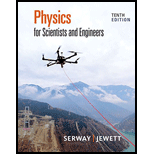
Review. Two boys are sliding toward each other on a frictionless, ice-covered parking lot. Jacob, mass 45.0 kg, is gliding to the right at 8.00 m/s, and Ethan, mass 31.0 kg, is gliding to the left at 11.0 m/s along the same line. When they meet, they grab each other and hang on. (a) What is their velocity immediately thereafter? (b) What fraction of their original kinetic energy is still mechanical energy after their collision? That was so much fun that the boys repeat the collision with the same original velocities, this time moving along parallel lines 1.20 m apart. At closest approach, they lock arms and start rotating about their common center of mass. Model the boys as particles and their arms as a cord that does not stretch. (c) Find the velocity of their center of mass. (d) Find their angular speed. (e) What fraction of their original kinetic energy is still mechanical energy after they link arms? (f) Why are the answers to parts (b) and (e) so different?
(a)
The velocity of Jacob and Ethan immediate thereafter.
Answer to Problem 38AP
The velocity of Jacob and Ethan immediate thereafter is
Explanation of Solution
The mass of Jacob is
The momentum is conserved in the isolated system of two boys then,
Here,
Substitute
Conclusion:
Therefore, the velocity of Jacob and Ethan immediate thereafter is
(b)
The fraction of their original kinetic energy is still mechanical energy after their collision.
Answer to Problem 38AP
The fraction of their original kinetic energy is still mechanical energy after their collision is
Explanation of Solution
The formula to calculate initial kinetic energy of the system is,
Substitute
The formula to calculate final kinetic energy of the system is,
Substitute
The formula to calculate fraction of kinetic energy is,
Conclusion:
Therefore, the fraction of their original kinetic energy is still mechanical energy after their collision is
(c)
The velocity of the centre of mass of Jacob and Ethan.
Answer to Problem 38AP
The velocity of the centre of mass of Jacob and Ethan is
Explanation of Solution
The velocity of the centre of mass of Jacob and Ethan is still remains same as calculated in part (a) because the conservation of momentum calculations will be same as part (a).
Then, the velocity of the centre of mass of Jacob and Ethan is,
Conclusion:
Therefore, the velocity of the centre of mass of Jacob and Ethan is
(d)
The angular speed of Jacob and Ethan.
Answer to Problem 38AP
The angular speed of Jacob and Ethan is
Explanation of Solution
The position of the centre of mass of the boys is,
Substitute
The Jacob is
The angular momentum is,
Substitute
Conclusion:
Therefore, the angular speed of Jacob and Ethan is
(e)
The fraction of their original kinetic energy that is still mechanical energy after they link arms.
Answer to Problem 38AP
The fraction of their original kinetic energy that is still mechanical energy after they link arms is
Explanation of Solution
Refer to the section 1 of part (b), the initial kinetic energy is,
The formula to calculate final kinetic energy of the system is,
Substitute
The fraction of kinetic energy is,
Conclusion:
Therefore, the fraction of their original kinetic energy is still mechanical energy after they link arms is
(f)
The reason for the answer of part (b) and part (e) is so different.
Answer to Problem 38AP
The answer of part (b) and part (e) is so different because the head on collision between similarly sized objects are grossly inefficient.
Explanation of Solution
The deformation is a process in which one form of energy changed into the other form. The head on collision between similarly sized objects are grossly inefficient. So the answers are so different. If the two kids were the same size and had the same velocity; conservation of the momentum states that they lose all their kinetic energy. On the other hand, glancing blows like this one allow a lot of energy to be transferred into the rotational kinetic energy, causing much less energy to be lost on impact.
Conclusion:
Therefore, the answer of part (b) and part (e) is so different because the head on collision between similarly sized objects are grossly inefficient.
Want to see more full solutions like this?
Chapter 11 Solutions
Physics for Scientists and Engineers
 Physics for Scientists and Engineers: Foundations...PhysicsISBN:9781133939146Author:Katz, Debora M.Publisher:Cengage Learning
Physics for Scientists and Engineers: Foundations...PhysicsISBN:9781133939146Author:Katz, Debora M.Publisher:Cengage Learning Principles of Physics: A Calculus-Based TextPhysicsISBN:9781133104261Author:Raymond A. Serway, John W. JewettPublisher:Cengage Learning
Principles of Physics: A Calculus-Based TextPhysicsISBN:9781133104261Author:Raymond A. Serway, John W. JewettPublisher:Cengage Learning Physics for Scientists and Engineers with Modern ...PhysicsISBN:9781337553292Author:Raymond A. Serway, John W. JewettPublisher:Cengage Learning
Physics for Scientists and Engineers with Modern ...PhysicsISBN:9781337553292Author:Raymond A. Serway, John W. JewettPublisher:Cengage Learning College PhysicsPhysicsISBN:9781305952300Author:Raymond A. Serway, Chris VuillePublisher:Cengage Learning
College PhysicsPhysicsISBN:9781305952300Author:Raymond A. Serway, Chris VuillePublisher:Cengage Learning University Physics Volume 1PhysicsISBN:9781938168277Author:William Moebs, Samuel J. Ling, Jeff SannyPublisher:OpenStax - Rice University
University Physics Volume 1PhysicsISBN:9781938168277Author:William Moebs, Samuel J. Ling, Jeff SannyPublisher:OpenStax - Rice University Classical Dynamics of Particles and SystemsPhysicsISBN:9780534408961Author:Stephen T. Thornton, Jerry B. MarionPublisher:Cengage Learning
Classical Dynamics of Particles and SystemsPhysicsISBN:9780534408961Author:Stephen T. Thornton, Jerry B. MarionPublisher:Cengage Learning





